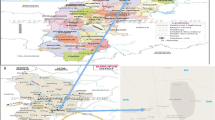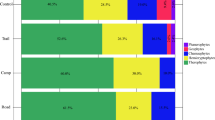Abstract
The effects of urban sprawl, at the expense of green natural areas, and the increasing anthropogenic pressure on these areas, lead to significant changes in land cover composition and structure. One of the threats and hazardous aspects of the urban sprawl is the disposal of construction site waste (CW) at the cities’ fringes and by the roadsides. The analysis of vegetation community structure over space and time in such areas may contribute to the understanding of community dynamics at the urban fringe following modern human intervention. Therefore, the purpose of this study was to characterize the composition and structure of vegetation communities in construction waste and rubble areas at the city of Haifa’s fringe. A control undisturbed site, and sites that were disturbed 20, 40 and 60 years prior to the study were selected and studied.
The results indicate that superficially there is no difference among the communities. A closer analysis, however, reveals that there is a significant segregation in species assembly between the control and the damaged sites, and that this difference becomes more significant as time passes. Initially, recently disturbed sites were characterized by a higher abundance of ruderal species, where mean number of ruderal species was 1.75/sampling quadrate, compared to 0.08 species/sampling quadrate. As time passes, the number of exotic species increased from 0.09 species/sampling quadrate at the 20 year disturbed site to 1.02 at the 60 year sites. Additionally, cover of climber species in the sites significantly increased with time, and other local life form groups declined in richness. Further, we have found that the impact of the CW is spreading beyond the area that it was found and into the open and undeveloped area that surround the city.







Similar content being viewed by others
References
Allen EB, Cox RD, Tennant T, Kee SN, Deatschman DH (2005) Landscape restoration in Southern California Forblands: response of abandoned farmland to invasive annual grass control. Isr J Plant Sci 53(3):237–245
Bossink BAG, Brouwers HJH (1996) Construction waste: quantification and source evaluation. J Constr Eng Manag 122(1):55–60
Brunner PH, Dominique MS (1993) Material balance of a construction waste sorting plant. Waste Manag Res 11(1):27–48
Clemente AS, Rego FC, Correia OA (1996) Demographic patterns and productivity of post-fire regeneration in Portuguese Mediterranean Maquis. Int J Wildland Fire 6(1):5–12
D’Antonio C, Meyerson LA (2002) Exotic plant species as problems and solutions in ecological restoration: a synthesis. Restor Ecol 10(4):703–713
D’Antonio CM, Vitousek PM (1992) Biological invasions by exotic grasses, the grass/fire cycle, and global change. Annu Rev Ecol Syst 23:63–87
Denslow JS, Pickett STA, White PS (1985) Disturbance-mediated coexistence of species
Feinbrun-Dothan N, Danin A, Plitmann U (1998) Analytical flora of Eretz-Israel Cana publishing house
Hannah L, Lohse D, Hutchinson C, Carr JL, Lankerani A (1994) A preliminary inventory of human disturbance of world ecosystems. Ambio: 246–250
Hill SJ, Tung PJ, Leishman MR (2005) Relationships between anthropogenic disturbance, soil properties and plant invasion in endangered Cumberland plain woodland, Australia. Aust Ecol 30(7):775–788
Hobbs RJ, Huenneke LF (1992) Disturbance, diversity, and invasion: implications for conservation. Conserv Biol 6(3):324–337
Holling CS (1973) Resilience and stability of ecological systems. Annual Review of Ecology and Systematics: 1–23
Hughes F, Vitousek PM (1993) Barriers to shrub reestablishment following fire in the seasonal submontane zone of Hawai’i. Oecologia 93(4):557–563
Israel Government Portal (2013) http://www.shituf.gov.il/discussion/422 Last accessed 25/06/2013. In Hebrew
Kowarik I (1990) Some responses of flora and vegetation to urbanization in central europe. Urban Ecology: Plants and Plant Communities in Urban Environments: 45–74
Kowarik I (2008) On the role of alien species in urban flora and vegetation. Urban Ecology: 321–338
Kowarik I, Pyšek P, Prach K, Rejmánek M, Wade M (1995) Time lags in biological invasions with regard to the success and failure of alien species. SPB academic publishing
Lake JC, Leishman MR (2004) Invasion success of exotic plants in natural ecosystems: the role of disturbance, plant attributes and freedom from herbivores. Biol Conserv 117(2):215–226
Larson DL, Anderson PJ, Newton W (2001) Alien plant invasion in mixed-grass prairie: effects of vegetation type and anthropogenic disturbance. Ecol Appl 11(1):128–141
McConnachie MM, Cowling RM, Van Wilgen BW, McConnachie DA (2012) Evaluating the cost-effectiveness of invasive alien plant clearing: a case study from South Africa. Biol Conserv 155:128–135
McDonnell MJ, Stiles EW (1983) The structural complexity of old field vegetation and the recruitment of bird-dispersed plant species. Oecologia 56(1):109–116
Meiners SJ, Pickett STA, Cadenasso ML (2002) Exotic plant invasions over 40 years of old field successions: community patterns and associations. Ecography 25(2):215–223
Millard A (2008) Semi-natural vegetation and its relationship to designated urban green space at the landscape scale in Leeds, UK. Landsc Ecol 23(10):1231–1241
Parendes LA, Jones JA (2001) Role of light availability and dispersal in exotic plant invasion along roads and streams in the HJ Andrews experimental forest, oregon. Conserv Biol 14(1):64–75
Peterken GF, Game M (1984) historical factors affecting the number and distribution of vascular plant species in the woodlands of central Lincolnshire. The Journal of Ecology: 155–182
Pickett STA, Cadenasso ML, Grove JM, Nilon CH, Pouyat RV, Zipperer WC, Costanza R (2008) Urban ecological systems: linking terrestrial ecological, physical, and socioeconomic components of metropolitan areas. Urban Ecology: 99–122
Pyšek PV (1994) Ecological aspects of invasion by Heracleum Mantegazzianum in the Czech republic. Ecology and management of invasive riverside plants. Wiley, Chichester, pp 45–54
Pyšek P, Chocholouskova Z, Pyšek A, Jarošík V, Milan C, Lubomír T (2004) Trends in species diversity and composition of urban vegetation over three decades. J Veg Sci 15(6):781–788
Pyšek PV, Jarošík PE, Hulme, J. Pergl, Hejda M, Schaffner U, Vilà M (2012) A global assessment of invasive plant impacts on resident species, communities and ecosystems: the interaction of impact measures, invading species’ traits and environment. Global Change Biology
Rebele F (1992) Colonization and early succession on anthropogenic soils. J Veg Sci 3(2):201–208
Rebele F (1994) Urban ecology and special features of urban ecosystems. Global Ecology and Biogeography Letters: 173–187
Rebele F, Lehmann C (2002) Restoration of a landfill site in berlin, Germany by spontaneous and directed succession. Restor Ecol 10(2):340–347
Salvati L, Zitti M (2012) Monitoring vegetation and land use quality along the rural–urban gradient in a mediterranean region. Appl Geogr 32(2):896–903
Scalera R (2010) How much is Europe spending on invasive alien species? Biol Invasions 12(1):173–177
Schnitzer SA, Bongers F (2002) The ecology of lianas and their role in forests. Trends Ecol Evol 17(5):223–230
Small C (2001) Estimation of urban vegetation abundance by spectral mixture analysis. Int J Remote Sens 22(7):1305–1334
Starfinger U, Sukopp H (1994) Assessment of urban biotopes for nature conservation. Landscape planning and ecological networks. Elsevier, Amsterdam, pp 89–115
Stylinski CD, Allen EB (2001) Lack of native species recovery following severe exotic disturbance in Southern Californian Shrublands. J Appl Ecol 36(4):544–554
Sukopp H (1998) Urban ecology-scientific and practical aspects
Sukopp H, Werner P (1983) Urban environments and vegetation. GEOBOTANY
Sukopp H, Hejný S, Kowarik I (1990) Urban ecology: plants and plant communities in urban environments balogh scientific books
Tilman D (1986) Evolution and differentiation in terrestrial plant communities: the importance of the soil resource: light gradient. Community Ecology: 359–380
Van Wilgen BW, Cowling RM, Marais C, Esler KJ, McConnachie M, Sharp D (2012) Challenges in invasive alien plant control in South Africa. S Afr J Sci 108(11/12):3
Vitousek PM, Lawrence RW (1989) Biological invasion by Myrica Faya in Hawai’i: plant demography, nitrogen fixation, ecosystem effects. Ecol Monogr 59(3):247–265
Zink TA, Allen MF, Heindl‐Tenhunen B, Allen EB (1995) The effect of a disturbance corridor on an ecological reserve. Restor Ecol 3(4):304–310
Zipperer WC, Wu J, Pouyat RV, Pickett STA (2000) The application of ecological principles to urban and urbanizing landscapes. Ecological Applications: 685–688
Acknowledgments
The authors are thankful to the late Prof. Z. Naveh for his support and valuable advice which led to this study.
This study was partially supported by a grant from JNF and a grant from the Reuven Chaikin Chair in Geostrategy.
The authors thank Mrs. Noga Yoselevich for making the drawing
Author information
Authors and Affiliations
Corresponding author
Appendix 1
Appendix 1
Rights and permissions
About this article
Cite this article
Kopel, D., Malkinson, D. & Wittenberg, L. Characterization of vegetation community dynamics in areas affected by construction waste along the urban fringe. Urban Ecosyst 18, 133–150 (2015). https://doi.org/10.1007/s11252-014-0396-6
Published:
Issue Date:
DOI: https://doi.org/10.1007/s11252-014-0396-6




